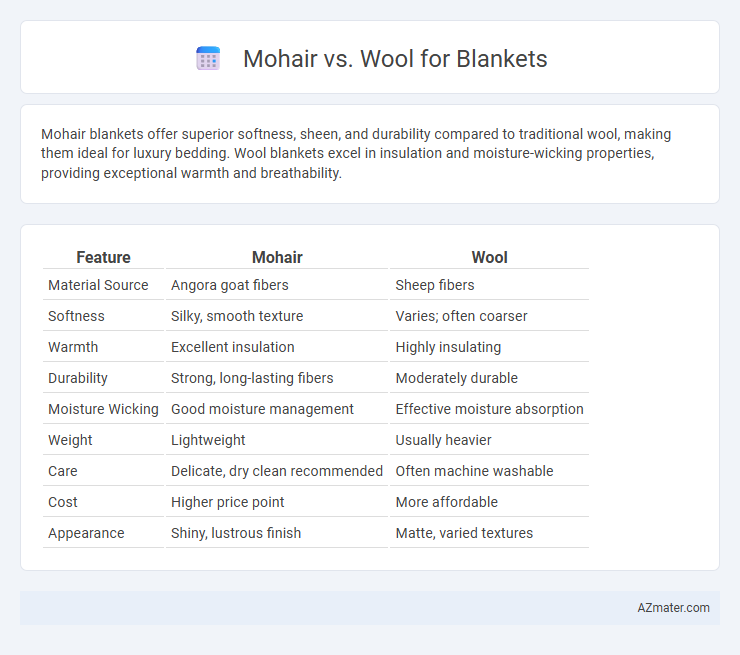Mohair blankets offer superior softness, sheen, and durability compared to traditional wool, making them ideal for luxury bedding. Wool blankets excel in insulation and moisture-wicking properties, providing exceptional warmth and breathability.
Table of Comparison
| Feature | Mohair | Wool |
|---|---|---|
| Material Source | Angora goat fibers | Sheep fibers |
| Softness | Silky, smooth texture | Varies; often coarser |
| Warmth | Excellent insulation | Highly insulating |
| Durability | Strong, long-lasting fibers | Moderately durable |
| Moisture Wicking | Good moisture management | Effective moisture absorption |
| Weight | Lightweight | Usually heavier |
| Care | Delicate, dry clean recommended | Often machine washable |
| Cost | Higher price point | More affordable |
| Appearance | Shiny, lustrous finish | Matte, varied textures |
Introduction to Mohair and Wool
Mohair, derived from the Angora goat, is renowned for its silky texture, natural sheen, and exceptional durability, making it a luxurious choice for blankets. Wool, primarily sourced from sheep, offers versatile warmth, breathability, and moisture-wicking properties, ideal for a wide range of blanket styles. Both fibers provide unique insulation benefits, with mohair excelling in softness and luster, while wool is prized for its resilience and insulating efficiency.
Origin and Production Methods
Mohair originates from the Angora goat, primarily raised in South Africa, Turkey, and the United States, with the fiber harvested through shearing twice a year, ensuring long, silky strands. Wool, derived mainly from sheep breeds such as Merino, is produced globally with Australia and New Zealand as leading exporters, involving shearing once annually and subsequent cleaning and carding processes. The distinct animal sources and seasonal shearing schedules influence the texture and warmth qualities unique to each blanket material.
Texture and Softness Comparison
Mohair, derived from the Angora goat, offers a silky, smooth texture that feels lightweight yet luxurious against the skin, ideal for blankets focused on softness and sheen. Wool, particularly Merino, provides a denser, cushioned feel with superior insulation, delivering warmth through its slightly coarser but resilient fibers. Choosing between mohair and wool blankets depends on the desired balance of softness, breathability, and thermal retention for personal comfort.
Warmth and Insulation Properties
Mohair blankets, derived from the Angora goat, provide superior insulation due to their hollow fiber structure, which traps air effectively and retains heat, making them exceptionally warm. Wool blankets, sourced from sheep, offer dense fibers that absorb moisture while maintaining warmth, enhancing their insulating properties in cold and damp conditions. Both materials excel at thermal regulation, but mohair's silky texture and lightweight warmth make it ideal for insulated, breathable blankets.
Durability and Longevity
Mohair blankets offer exceptional durability due to mohair fibers' resilience, which resist wear and maintain softness over time, making them ideal for long-lasting use. Wool blankets, while also durable, tend to pill and shed more quickly under heavy use, reducing their longevity compared to mohair. The inherent strength and elasticity of mohair fibers contribute to blankets that retain shape and appearance significantly longer than typical wool counterparts.
Moisture-Wicking and Breathability
Mohair blankets excel in moisture-wicking due to their smooth fiber structure, efficiently drawing sweat away from the skin to keep sleepers dry. Wool offers superior breathability with its crimped fibers that trap air, providing excellent insulation while allowing airflow to regulate temperature. Both fibers naturally balance moisture and air circulation, but mohair's silk-like sheen makes it lighter and cooler compared to the denser warmth of wool.
Hypoallergenic Qualities
Mohair blankets, made from Angora goat fibers, exhibit natural hypoallergenic properties due to their low allergen content and resistance to dust mites, making them suitable for sensitive skin. Wool blankets, particularly those from sheep, can sometimes trigger allergic reactions because of lanolin and other proteins, although processed wool may reduce this risk. Choosing mohair over wool enhances comfort for allergy-prone individuals seeking cozy, breathable, and irritation-free blankets.
Maintenance and Care Guidelines
Mohair blankets require gentle care with cold water washing and air drying to preserve their sheen and softness, while wool blankets benefit from regular brushing and spot cleaning to prevent pilling and maintain insulation. Both fibers should be kept away from direct heat sources and stored in breathable bags to avoid moisture buildup and moth damage. Proper maintenance extends the lifespan of each fabric, ensuring lasting warmth and durability.
Price and Value Analysis
Mohair blankets generally come at a higher price point due to the luxurious texture and rarity of Angora goat fibers, which offer exceptional durability and sheen compared to traditional wool. Wool blankets, especially those made from sheep's wool varieties like Merino, provide strong insulation and moisture-wicking properties at a more affordable cost. Evaluating value, mohair blankets deliver long-term investment benefits through softness and hypoallergenic traits, while wool blankets excel in warmth and budget-friendliness for everyday use.
Choosing the Best Fiber for Your Blanket
Mohair, sourced from Angora goats, offers exceptional softness, durability, and a natural luster, making it an ideal choice for luxurious blankets needing lightweight warmth and breathability. Wool, primarily from sheep, provides superior insulation, moisture-wicking properties, and elasticity, perfect for cozy, warm blankets that retain heat effectively. Selecting between mohair and wool depends on the desired balance of softness, warmth, and durability for your specific blanket needs.

Infographic: Mohair vs Wool for Blanket
 azmater.com
azmater.com